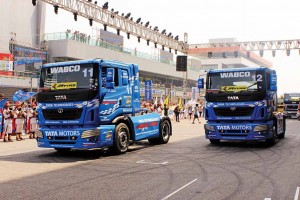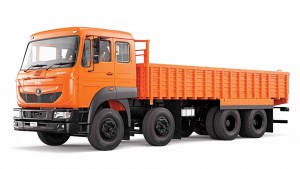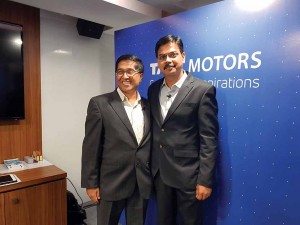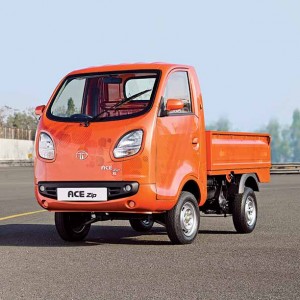Tata Motors is banking on new products and technologies to drive growth.
Story by:
Bhushan Mhapralkar
Tata Motors will launch four new medium- and heavy-duty commercial vehicles (M&HCVs) in the FY2017-18 financial year. It will also introduce five intermediate and light commercial vehicles (I&LCVs). Experiencing good sales rise in the second quarter of this fiscal, the company, to address the demand for higher payload and better TCO requirements, will introduce LPS 4923 6×4 tractor, LPK 2518 HD 6×2 tipper, LPTK 3118 8×4 tipper, Signa 3718 rigid and LPTK 2518 6×4 tipper in the M&HCV segments. In the I&LCV segments, it will introduce Ultra 1518, Ultra 1412, Ultra 1014, Ultra 710 (with 1.9 m cabin), and LPT 709 CNG. Engaging with dealers and customers according to Girish Wagh, head of commercial vehicles business, Tata Motors will invest Rs.1500 crore across haulage application categories to stay ahead; to further cement its leadership.
Targeting segments that the company was either not present in, or did not have enough marketshare, the company has been driving the XL range of small CVs in the sub 3.5-tonne segment. To increase the reach, Tata Motors is carrying out a high number of regional engagement activities. Selling 27,842 vehicles in July 2017, up 15 per cent year-on-year, the company has embarked on a business turnaround plan that aims at a strong bottom-line improvement. Selling 45,906 vehicles in August 2017, up 26 per cent year-on-year, the CV maker is not interested in buying the market share according to Girish. Suffering a decline of more than 17 per cent in CVs when compared to last year, efforts to increase the ability to respond to market changes quickly, and to be cost competitive are being carried out. If the regional engagement activities are presenting the CV maker with a terrific opportunity to interact with customers, attention is also on the performance of the Xenon Yodha product-line. “It (Xenon Yodha) is doing very well on the count of fuel efficiency, and in the last three-to-four months of the launch, we have gained a market share of 4.5 per cent,” said Girish.
Tracking the performance of buses in the segments that the Ultra is in, Tata Motors is coming out with a range of Ultra buses. This includes an automated manual transmission model too. To compete in the 40-45 seater bus market, the CV maker has launched the flagship Magna bus. Working to respond to the market requirement of a hard-top Magic SCV, Tata Motors, said Girish, is working on a host of safety tehnologies and programs. It is ready with the stability program, and will launch it shortly. Driving a six-pillar strategy that includes dealer and key account engagement, operational excellence, product interventions, defence business, technology and powertrain road map, and international business, the company is also working on Automonous Emergency Braking (AEB), lane departure warning, and technologies that will enhance safety and lead to autonomous driving.
Safety tech & modularisation
With many advanced technologies that will help to reach the autonomous stage claimed to be in advanced development stages, Tata Motors is evaluating how they can be deployed to address product aspirations. To improve short-term performance, and to come out with exciting products will be key, said Girish. He pointed at the development of modularisation road map as an answer. “The number of parts in a CV have been converted into 32 modules. They have been grouped in 12 zones. All the zones and groups have been designed into a standardised and modular fashion, and can replace a zone or a module to create a variant,” explained Girish Wagh. Expected to help address market changes faster, the modular approach should enable Tata Motors to meet any demand change quickly. Especially in the case of fully-built CVs, the demand for which is rising. Working on a lot of technologies, some of which are in the drive-out stage and some are in the advanced stages of development, Tata Motors is confident of the deployment of 25 Starbus Hybrid low-floor city buses in Mumbai. Of these, five buses have been registered and will soon start operating. Showcasing Tata Motors’ abilities in terms of design, technology and experience, the Starbus Hybrid mirrors the Tata Hispano CNG hybrid buses that are plying on the roads of Madrid.
Working on LNG in the alternate fuel technology space, Tata Motors is keen to offer the lowest total cost of ownership. Described Girish that LNG technology development is at an advanced stage. The company has already produced a few LNG engines. Talking to Petronet LNG and IOCL to understand the nature of infrastructure the two oil majors will set up, the CV maker is looking at Delhi-Mumbai and Kolkata-Mangalore corridor. The Ultra electric bus, available in a nine-meter and 12 m length, is already on trial in certain domestic markets according to Girish. Ready to supply such buses as per the demand, Tata Motors has also developed a fuel cell bus in association with ISRO. Work on this is at an advanced stage. Stating that customers do not buy on price alone, Girish signaled a change in customer demand. He mentioned that they are looking at ‘comfort’. Concentrating on the development of LNG vehicles that are safe, efficient and comfortable, Tata Motors, according to Girish, is looking at offering a lower cost of operation.
Addressing dealer concerns
Paying attention to the pain points of the dealers regarding profitability and the ability to respond quickly, and how the same could be addressed jointly, Tata Motors is taking suitable measures. Supporting the dealers from the back-end, the company has created a team of ‘Dronas’. These are expert drivers that reach out to customers; travel with them for the distance required, and train the drivers to achieve higher efficiency. Also helping to overcome any difficulty customers may face, the ‘Dronas’, said Girish, are able to explain the changes in technology that have been triggered by the move to BSIV emission regulations in terms of caliberation, etc. Proving to be an effective interface between the CV OEM and the customer, the ‘Dronas’, according to
RT Wasan, Vice President – Sales & Marketing, Commercial Vehicles, Tata Motors, are paving the way for effective communication. The team of 40 ‘Dronas’ was setup almost a year ago, and strengthened, said Wasan. Apart from the ‘Dronas, Tata Motors has also set up a team of ‘Acharyas’. These include over 15000 mechanics apart from those that are a part of Tata Motors’ own network. Trained to service BSIV vehicles, they are a part of the endeavour to deliver ‘comfort’. The best part perhaps is, the ‘Dronas’ and ‘Archaryas’ are providing a feedback on how the vehicles are performing.
Expecting to ride the rise in GDP growth for the remaining three quarters, and the rise in the manufacturing index, the company is observing a change in the buying decision. Confident of yielding positive results on the basis of a cost reduction program, Tata Motors is working towards recovering the loss it incurred. Close to 40 per cent of the BSIII CVs have been dealt with. Stressing upon income from non-vehicles sales areas like spare parts and Prolife, the company is driving exports to de-risk domestic market cyclicity to an extent. According to Girish, last year was a record year as far as international business is concerned. With an eye on the future regulations, including BSVI emission standards that are slated to come in forced by 2020, Tata Motors is segment-by-segment defining value enhancers, which will provide ‘comfort’ to the customer. Acutely aware of the rising stress for alternate fuel vehicles, the CV maker is marrying technological developments to not just meet the regulations, but to enhance customer experience. Stated Girish, that the demand for value trucks in terms of rated payload is increasing. He explained, “With the implementation of rated payload, customers are looking at maximum payload that they could get within the given GVW.” Stating that they want to align with the government’s intent to elevate safety and reduce CO2 emissions, Girish concluded, “Our focus would be to deliver it economically.”























